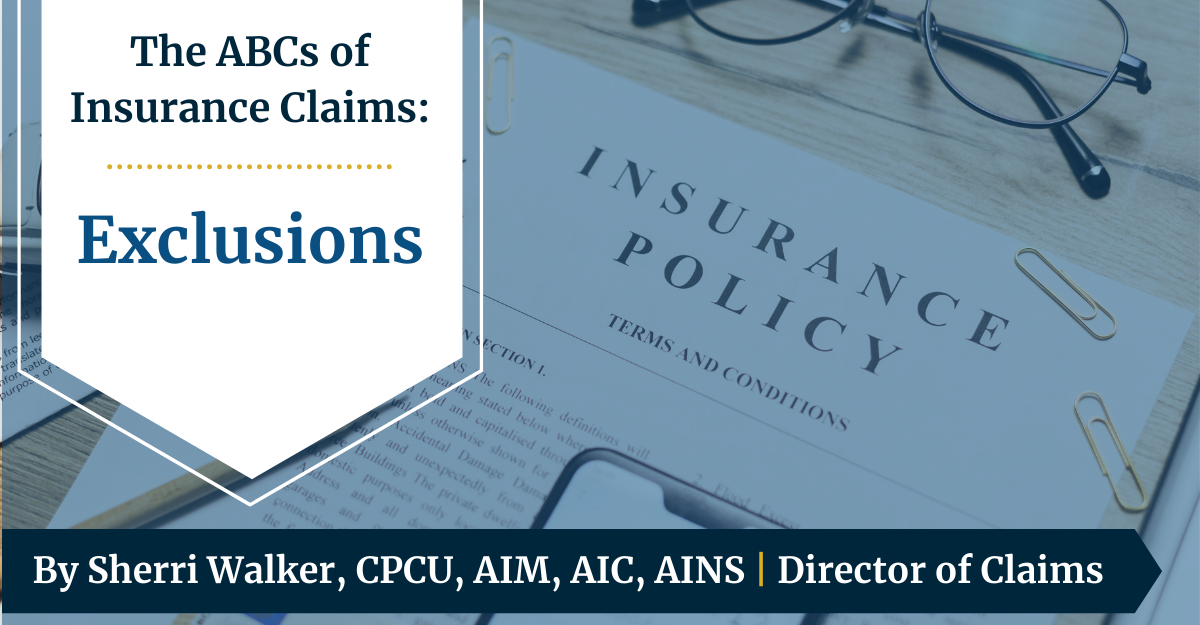Welcome to the ABCs of Insurance Claims. Over the next few months, Sherri Walker, Sentinel’s Director of Claims will address an aspect of claims handling for every letter of the alphabet to help provide a better understanding of the claims process.
Exclusions - Insuring Agreement
Anyone who has ever looked at their insurance policy has likely noticed that it is a long, drawn-out document that reads like a foreign language. With paragraphs on both sides of the pages, and jargon all its own, most people will quickly stop reading and just trust that they are protected from any and all terrible things imaginable. Unfortunately, that isn’t the case.
Within those pages, paragraphs and words resides essential information about what your policy covers, but more importantly, what it does not. It is extremely important to understand what isn’t covered before you have a claim.
There are several sections to every Insurance policy. The section we will discuss here includes the Insuring Agreement, which addresses the “meat and potatoes” of coverage. This is the portion of the policy where conditions, limitations, and our topic for today – Exclusions – are spelled out.
What Is An Exclusion?
A large portion of policies are written on what’s considered an “Open Perils” basis. This means that unless a loss is specifically excluded, it’s covered. An exclusion is the policy provision that formally defines what is not covered by the policy. Exclusions come in many forms – which can mainly be summed up as excluded perils, excluded property or excluded actions. As you can imagine, there are a considerable number of exclusions in all insurance policies, and they can vary widely.
The number and breadth of exclusions vary by policy. As you can imagine, very different exclusions are written into property policies versus workers compensation policies. Some exclusions can be very specific in nature, such as “Nuclear Hazard” or very broad such as “Water.” The broad exclusions are usually broken down in other areas of the policy, and coverage for specific losses related to the broad exclusion may be added back with a limitation or condition. These coverages may also be added back in full or in part by endorsement.
The Most Common Exclusions
Many types of risks are generally excluded in most policies, and typically fall into the categories of:

Natural Disaster/Catastrophes
While there is some coverage for certain damages (think wind/hail in non-catastrophe areas) from storms, there are exclusions regarding flood, earthquake, tsunami & land movement in many forms. These are losses that are excluded under most every policy, and specific policies can be written only to cover these perils.

Losses Covered Elsewhere
Each policy is intended to provide coverage for specific types of property or liability exposures. For example, a Homeowner’s policy will exclude Autos, and an Auto policy will exclude damage to your own home. A General Liability policy will not cover Professional Liability (such as a malpractice matter), and vice versa. Additionally, if you have a scheduled piece of property, the coverage for that property would need to be filed on that Inland Marine policy instead of your general property policy. These exclusions are added to enforce that the proper coverage is procured for each exposure.

Intentional and Fraudulent Acts
This includes intentional damage, war, and crimes that you commit.

Maintenance/Warranty Issues
Insurance policies are written to cover sudden & accidental damage, and will not cover wear & tear, neglect, deterioration, or most mechanical failure. Your insurance policy is not a maintenance policy.
Why Are There Exclusions?
While it may seem that there are a lot of things that your policy doesn’t cover, it’s important to understand that these exclusions serve an important purpose. Exclusions are added to clarify the overall intention of the policy and sometimes to restrict the policy offerings where either the risk is too high, the loss should be covered elsewhere, or the loss should be unavoidable.
Insurers use exclusions to manage the overall risk and keep rates and premiums affordable. By choosing to eliminate coverage for specific types of loss, carriers are able to keep premiums economical while having enough funds to cover the claims that are owed. More so, excluding certain types of damages keeps insurance from being used by policy holders for general upkeep & upgrades. An exorbitant amount of these types of losses would drive insurance premiums to a level that would make it unaffordable by most.
How Do I Know If My Loss Is Excluded?
In many instances, there are clear cut exclusions, such as worn outdoor brick stairs crumbling over time, or a flood loss. However, in other instances, a careful review of the policy is needed.
Your insurance professional should review coverages and exclusions with you at each renewal. It is important to understand when coverage applies and when it does not to make an informed buying decision. All programs are not created equally. The time to find out about an exclusion is not at the time of loss adjustment. Many times, losses are denied based on policy exclusions.
At Sentinel, we will review any denials you receive based on these exclusions and determine if there are other potential avenues for coverage. As always, if you would like a further review of your policy to ensure that your coverage needs are met, the dedicated team at Sentinel stands ready to evaluate your needs and mitigate potential claims issues. Partner with us to Safeguard Your Success today.


